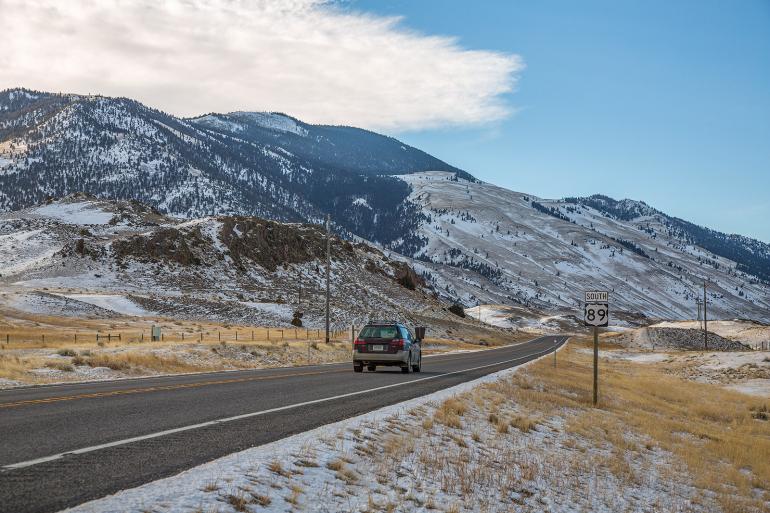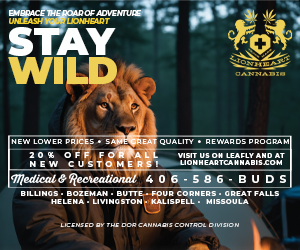News & Notes: Winter 2024-25
Happenings from around the Bozone and southwest Montana.
R.I.P. 399
The Greater Yellowstone Ecosystem lost an icon last October, with the death of Grizzly #399 (who, it should be noted, deserved a name—shame on those stuffy wildlife biologists). The 28-year-old sow was killed in a collision with a Subaru Outback south of Jackson. Over her incredibly long life, she produced 18 offspring, drew an enormous following from all over the world, and was the subject of a PBS documentary called Queen of the Tetons. Her body was cremated by the Fish & Wildlife Service, and her ashes scattered in the Pilgrim Creek area of Grand Teton National Park, where she spent most of her time. Still, her legacy will live on in the form of her progeny, and in the conservation ethos she brought to the park by means of her loyal following. Thanks, Teton Queen—you will be missed. —Eli Fournier
WILDLIFE WELFARE
Here at O/B, we’ve been covering the issue of highway wildlife crossings pretty heavily the last few years. Why are there no underpasses or overpasses in southwest Montana, how are we going to change that, and where will the money come from? If you want insight into these questions, check out Corey Hockett’s article, “Unsafe Passage” in the Spring 2024 issue. But regardless of how closely you’ve been tracking things, there’s good news to report. In October, Yellowstone Safe Passages—a nonprofit group—announced that they’d received a grant from the Montana Wildlife & Transportation Partnership to conduct an engineering feasibility study on a section of Hwy. 89 in Paradise Valley, adjacent to the Dome Mountain Wildlife Management Area. Historically, it’s been the deadliest section of highway in the valley, especially in winter when elk herds from the northern end of Yellowstone and west side of the Gallatins converge on the area. Completion of the feasibility study will help the project tap into larger federal grants to fund the $35-million crossing, hopefully in the near future. Now if only we could follow suit on Hwy. 191, where some kind of wildlife—and driver—safety measure is long overdue. —Eli Fournier
THE BIGGER PICTURE
As bulldozers continue to ream out the Gallatin Valley, many folks are looking further down the road—decades in fact. What’s this place—the Greater Yellowstone Ecosystem—going to look like in 20 years? How about 30? And 50? These people, on behalf of the Gallatin Forest Partnership, have put together the Greater Yellowstone Conservation and Recreation Act (GYCRA)—proposed legislation that would provide permanent defense for the Madison and Gallatin ranges from future development. While still in the process of garnering support, the act would protect habitat, ensure public access to recreation, and safeguard the multitude of waterways providing cities including Bozeman, Big Sky, West Yellowstone, and Livingston—just to name a few—with clean drinking water.
Specifically, the GYCRA would slow development—for both resource extraction and recreational purposes—on 250,000 acres of public land adjacent to Bozeman. Broken down further, that would notably include a 22,000-acre expansion of the Lee Metcalf Wilderness Area, and the designation of a new 102,000-acre swath of public land as the “Gallatin Wilderness Area.” The latter would extend from the southern end of Hyalite Reservoir to the boundary of Yellowstone, and east to include the West Pine trailhead in Paradise Valley, along a handful of others. The former would annex the area known as “Cowboy Heaven” on the west side of the Madisons, and add 6,400 acres to the Taylor-Hilgard Unit on the southern end of the range.
Overall, the plan is contentious—it would add nonmotorized restrictions to a number of trails in the Gallatin Range, while altogether banning the construction of new trails in many areas. Logging would see even more restrictions. Still, it’s certainly worth asking ourselves: what can we do now, to ensure that we have wildlife, clean water, and untrammeled land for years to come? Let’s get a head-start on this one, rather than waiting until it’s too late. To learn more, visit greateryellowstoneact.org. —Carson Sprague
MINE TO OURS
We’ve been hearing about it for years, but in June of this year, the second phase of the Absaroka-Beartooth Gateway Acquisition was completed with the purchase of three former mining claims just north of Cooke City. The acquisitions were made possible by senator Jon Tester’s 2019 Yellowstone Gateway Protection Act, which permanently withdrew federal mineral rights and forbade the expansion of mining activity onto unclaimed lands adjacent to Yellowstone. Nestled between Yellowstone Park and the Absaroka-Beartooth Wilderness, the parcels collectively add 61 acres to the Custer-Gallatin National Forest, which is sure to expand access into an already-popular winter location for folks from Bozeman, Billings, and beyond. Aside from benefits to us featherless bipeds, the land is also critical habitat for bald eagles, elk, grizzly bears, and a whole slew of other wildlife species. In sum, the acquisition is a long-awaited conservation landmark, and a reminder as to the importance of the federal Land and Water Conservation Fund, which was suckled on to purchase the land in the first place. Though election season is over—for now—keep in mind who’s fighting for our open spaces, wildlife, and public lands when enjoying the Custer-Gallatin and all its recreational opportunities in the future. —Carson Sprague















